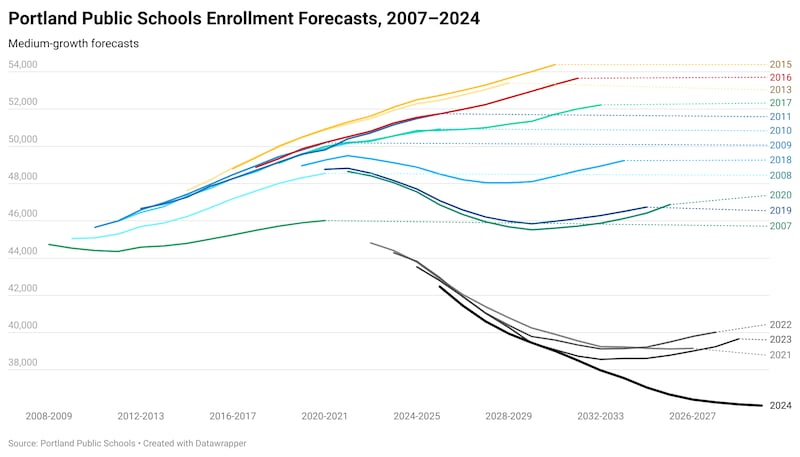An annual forecast for Portland Public Schools, conducted by the Population Research Center at Portland State University, projects enrollment will continue to decline at the district through the 2034–35 school year. That matters for the district’s budget because PPS gets state funding for each student it reports.
The forecast found the district faces two challenges: Birth rate in the Portland area is declining, and fewer families are choosing to enroll their students in PPS. In March, PSU demographer Dr. Ethan Sharygin told WW his forecasts were based on an assumption that the status quo would continue.
But the projections also tell a broader story about Portland, says one of the city’s top pollsters, John Horvick, who runs DHM Research.
Horvick posted a chart Aug. 8 mapping PSU’s enrollment forecasts for PPS from 2007 through the latest forecast. The graph shows a stark decline in demographers’ optimism for the district’s enrollment recovery.

The 2015 forecast, for example, predicted about 55,000 students for the 2028–29 school year. The latest forecast predicts PPS will dip below 40,000 that year, enrolling 39,945—about a 27% decline.
“It just seems really fast, the shift in population demographic changes,” Horvick says, adding that a changing and aging population “is really important for long-term choices” and will matter for Portland’s future. “It has to matter…the choices we make to invest in kids, in schools, versus whether we have an aging population, and the choice we make to invest in housing affordability or senior health services,” he says. “Those things are going to matter.”
Portland, like other urban areas nationwide, has seen a decline in school enrollment that’s faster than the national average. An analysis from FutureEd and The 74, released Monday, also points toward domestic migration as a reason why so many urban districts are seeing the steepest dropoffs in enrollment.
That analysis also shows that nationwide, Oregon has seen one of the sharpest enrollment declines between the 2019-20 and 2023-24 school years, losing 6.2% of its students. Tara Moon, the author of that analysis, notes that enrollment loses will have ripple effects well beyond program cuts. For example, if there aren’t as many students, schools need fewer teachers and could conduct layoffs damaging to local economies.
“Today’s enrollment declines don’t seem like a temporary disruption, and districts are going to have to deal with this new reality,” Moon writes. “As enrollment patterns continue to change, school districts will need to respond by balancing fiscal responsibility with community needs.”

